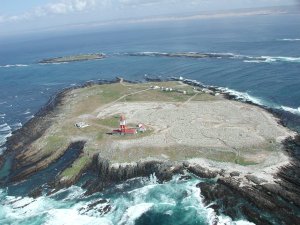BIRD ISLAND MARINE PROTECTED AREA CELEBRATES TEN YEARS

Addo Elephant National Park (AENP), the custodians of the Bird Island Marine Protected Area (MPA) off Algoa Bay, celebrated the tenth anniversary since the proclamation of the area, recently.
The Bird Island MPA was officially proclaimed by former Minister of Environmental Affairs, Marthinus van Schalkwyk, in the Government Gazette on 4 June 2004. The news cemented the Park’s eastern boundary in Algoa Bay and also gave AENP the status of being the only national park in the world to be able to boast with the title of being home to the world’s Big 7 – with the addition of the seasonal Great White Shark and Southern Right Whale in the water off Algoa Bay to the Big 5.
The Bird Island group (Bird, Seal and Stag Islands) is home to several species of red-data listed seabirds - including the Cape gannett, roseatte tern and African penguin - while the reefs around the islands are important for abalone and linefish. Bird Island was increasingly becoming the target of abalone poachers at the time, and the immediate protection of the islands was regarded as a priority.
However, the declaration of the MPA had little effect on the plundering of abalone taking place around the islands and in 2006 a complete dive ban implemented. This had some effect, but still the plundering continued.
At the same time, the area around the Bird Island MPA became a popular fishing zone for recreational and commercial fishing vessels. This was due to the fact that the MPA created a safe haven for over-exploited line and reef fish to breed, that had a fish spill-over effect in the surrounding area where these fishing vessels liked to fish. Unfortunately some fishermen were not prepared to fish outside the MPA and were on a regular basis caught fishing inside it.
In 2008 Addo Elephant National Park established a Marine section of rangers, to provide an ever-vigilant presence in the area. The nine-person team alternates between being based on Bird Island and on vessels in and around the MPA, and have made a number of arrests and confiscated numerous vessels over the years.
Plans are now afoot to have a greater MPA declared, which will add another 120 000ha to the current 7 00ha MPA. This area will stretch for about 75km along the coast from the Port of Ngqura to Cannon Rocks near Alexandria. Offshore, at it’ll go out for as far as 20km at its furthest point.
The idea behind a Marine Protected Area (MPA) started in 1997 under the Greater Addo project. Research into baseline environmental and fisheries data was carried out between 2006 and 2012, systematic conservation and draft management plans have been completed and an economic cost benefit analysis has been carried out. There has also been nearly eight years of consultation between South African National Parks, Marine and Coastal Management, the Departments of Environmental Affairs and Forests and Fisheries, and key stakeholders such as Commercial fisheries (squid, hake, sardine, shark longline and linefish), the Coega Industrial Development Zone, Transnet National Ports Authority, recreational fishers and the larger public.
The most recent of these took place in August last year when SANParks and the Departments of Environmental Affairs and Agriculture, Forestry and Fisheries met with commercial fisheries in Port Elizabeth to further discuss the proposed MPA off Algoa Bay – a biodiversity hot spot along the South African coast.
The area is key as it is home to the highest percentage of endemic line fish species, hosts the largest breeding populations of gannets and penguins and has the longest, most productive sandy beach in the Southern Hemisphere.
The main objectives of the MPA are to conserve biodiversity, focus on threatened, over overexploited species, contribute to rebuilding fish stocks and minimising conflict and cost to fisheries activities.
The input from the sessions with the industries was used in a proposal of regulations to DEA: Oceans and Coasts, who will now prepare the document for the Minister. She will then have to gazette an “Intent to declare an MPA”, which will afford the public 60 days’ comment and during which further public meetings will be held. Issues raised during this time will have to be addressed by the department within 30 days. Thereafter, the Minister will hopefully gazette the “Declaration of the MPA”.





















 Please wait!
Please wait!